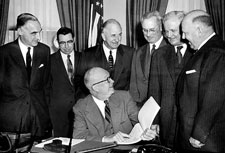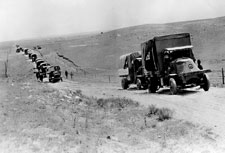Most state highways in the 1940's were two lanes. Only a handful of divided highways existed. Highway death rates were more than four times higher on a per mile traveled basis than today. Certain states with heavier traffic volumes overcame weak state and federal funding by building toll roads. The first U.S. toll road was the Pennsylvania Turnpike, which opened in 1940, followed in the post-war years by others in Illinois, Ohio, New Jersey, Indiana and Massachusetts. These four or six-lane divided highways, with limited access, flatter curves, and lower grades were thoroughbreds by comparison. Many of their design features were inspired by Germany's Autobahn, which was constructed in the 1930s.
There was little advocacy for an interstate highway system during President Truman's tenure. Economic recovery, the national housing shortage, the emergence of the Cold War, and the Korean War (1950-53) all took precedence.
 |
| Visionary: In January 1955 President Eisenhower met with his Advisory Committee on a National Highway Program to discuss their report, A Ten-Year National Highway Program, which included a plan for financing the Interstate System. Left to right: General Lucius D. Clay, Francis C. Turner of the Bureau of Public Roads, Steve Bechtel of Bechtel Corp., Sloan Colt of Bankers' Trust Co., Bill Roberts of Allis-Chalmers Manufacturing Co., and Dave Bech of the International Brotherhood of Teamsters. |
Enter President Eisenhower
Dwight Eisenhower revealed his interest in overhauling the nation's highway network in a 1952 campaign statement to the Hearst newspaper chain: "The obsolescence of the nation's highways presents an appalling problem of waste, danger and death. Next to the manufacture of the most modern implements of war as a guarantee of peace through strength, a network of modern roads is as necessary to defense as it is to our national economy and personal safety."
"We have fallen far behind in this task-until today there is hardly a city of any size without almost hopeless congestion within its boundaries and stalled traffic blocking roads leading beyond these boundaries. A solution can and will be found through the joint planning of the Federal, state and local governments."
 |
| Catalyst. Eisenhowers 1919 cross-country convoy sparked the idea of an Interstate system. photo courtesy of the eisenhower library |
Eisenhower's feelings about the need for better roads were deep-rooted. As a young lieutenant colonel in 1919, he got assigned to the Army's Coast-to-Coast Motor Transport Train. This was a convoy of dozens of trucks, aimed at testing vehicles under field conditions, promoting the Motor Transport Corps, interesting potential drivers and mechanics to apply for training, and supporting the good roads movement. From Pennsylvania west it followed the Lincoln Highway, the most famous cross-country route at that time, though it was still unimproved in many areas. Mechanical breakdowns, vehicles stuck in mud or sliding into ditches were common. The convoy carried pontoons in order to cross rivers where there were no bridges, to avoid lengthy detours.
Sixty two days after leaving Washington, D.C., they reached San Francisco. In his subsequent report of the expedition, Ike wrote that the trucks operated well on smooth, level roads but could not perform as cargo carriers "on rough roads, sandy ones, or on steep grades." In some places, "portions of the train [convoy] did not move for two hours." He found the pavement too narrow in many sections, forcing vehicles to ride partly off the road. Some excellent roads built years before had deteriorated, causing him to comment that "In such cases it seems evident that a very small amount of money spent at the proper time would have kept the road in good condition."
|
His thinking was also strongly influenced by his experience in World War II, when he served as Supreme Allied Commander for Europe. Army trucks suffered badly on the roads of France, Belgium and Holland. But in the words of Ninth Army bridge and highway engineer E.F. Koch, "after crossing the Rhine and getting into the areas of Germany served by the Autobahn our maintenance difficulties were over. Nearly all through traffic used the Autobahn and no maintenance on that system was required." Reflecting later in life, Eisenhower said that "after seeing the autobahns of modern Germany and knowing the asset those highways were to the Germans, I decided, as President, to put an emphasis on this kind of road building Germany had made me see the wisdom of broader ribbons across the land."
Eisenhower's first call for better highways after taking office was in his State of the Union Address in January 1954, the year the highway program was up for reauthorization. He said, "So that maximum progress can be made to overcome present inadequacies in the Interstate Highway System, we must continue the Federal gasoline tax at two cents per gallon." (Gasoline at that time cost about 25¢ per gallon.) The Federal-Aid Highway Act that Congress passed in May called for spending $2 billion over two years, essentially for improving existing roads rather than constructing highways on new alignments.
But Eisenhower's push for a coast-to-coast, border to border system of superhighways was just beginning. According to Richard F. Weingroff of the Federal Highway Administration, in April 1954 Eisenhower "told his staff he wanted a 'dramatic' plan to get $50 billion worth of 'self-liquidating highways' under construction (i.e., highways that would be financed without adding to the national debt)."
Eisenhower intended to go public with his plan at the National Governors Conference that July. Because his sister-in-law's funeral prevented his appearance, Vice President Richard Nixon addressed the governors, using the president's notes. Nixon explained the President's premise simply: "Our highway net is inadequate locally, and obsolete as a national system." The consequences he itemized were stark-an annual highway death toll approaching 40,000 ("comparable to a bloody war"), billions of dollars in economic losses resulting from detours and traffic jams, and manufacturing achievements negated by transport inefficiencies.
The president envisioned a program to achieve "the highway net as it should be a properly articulated system that solves the problems of speedy, safe, transcontinental travel-intercity communication-access highways-and farm-to-market movement-metropolitan area congestion-bottlenecks-and parking." The plan called for financing the program either by increasing the gas tax or by tolls.
Potholes along the way
Eisenhower had badly misjudged the receptivity of his audience. And he had proceeded so quickly his staff had not had time to do any advance work. Many of the governors were outraged. Their anger centered on two aspects, the federal gas tax, and federal dictation of highway building, which they considered their...
he birth of America's Interstate highway system in 1956 had a contentious and drawn out gestation. But today's 42,795-mile transportation marvel owes its development to the vision and determination of a quintessential American, Dwight D. Eisenhower.
Post a comment to this article
Report Abusive Comment